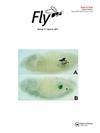Biology and ecology of the Oriental flower-breeding Drosophila elegans and related species
IF 2.2
4区 生物学
Q3 BIOCHEMISTRY & MOLECULAR BIOLOGY
引用次数: 4
Abstract
ABSTRACT Animals adapt to their environments in the course of evolution. One effective approach to elucidate mechanisms of adaptive evolution is to compare closely related species with model organisms in which knowledge of the molecular and physiological bases of various traits has been accumulated. Drosophila elegans and its close relatives, belonging to the same species group as the model organism D. melanogaster, exhibit various unique characteristics such as flower-breeding habit, courtship display, territoriality, sexual dimorphism, and colour polymorphism. Their ease of culturing and availability of genomic information makes them a useful model for understanding mechanisms of adaptive evolution. Here, we review the morphology, distribution, and phylogenetic relationships of D. elegans and related species, as well as their characteristic flower-dependent biology, food habits, and life-history traits. We also describe their unique mating and territorial behaviours and note their distinctive karyotype and the genetic mechanisms of morphological diversity that have recently been revealed.东方繁花果蝇及其近缘种的生物学与生态学
动物在进化过程中适应环境。研究适应进化机制的一种有效方法是将亲缘关系密切的物种与模式生物进行比较,在模式生物中积累了各种特征的分子和生理基础知识。秀丽果蝇及其近亲与模式生物黑腹果蝇同属一个物种群,在繁花习性、求偶行为、领地性、两性二态性和颜色多态性等方面表现出许多独特的特征。它们的易于培养和基因组信息的可用性使它们成为理解适应性进化机制的有用模型。本文综述了线虫及其近缘种的形态、分布和系统发育关系,以及它们特有的依赖花朵的生物学特性、食性和生活史特征。我们还描述了它们独特的交配和领土行为,并注意到它们独特的核型和最近揭示的形态多样性的遗传机制。
本文章由计算机程序翻译,如有差异,请以英文原文为准。
求助全文
约1分钟内获得全文
求助全文
来源期刊

Fly
生物-生化与分子生物学
CiteScore
2.90
自引率
0.00%
发文量
17
审稿时长
>12 weeks
期刊介绍:
Fly is the first international peer-reviewed journal to focus on Drosophila research. Fly covers a broad range of biological sub-disciplines, ranging from developmental biology and organogenesis to sensory neurobiology, circadian rhythm and learning and memory, to sex determination, evolutionary biology and speciation. We strive to become the “to go” resource for every researcher working with Drosophila by providing a forum where the specific interests of the Drosophila community can be discussed. With the advance of molecular technologies that enable researchers to manipulate genes and their functions in many other organisms, Fly is now also publishing papers that use other insect model systems used to investigate important biological questions.
Fly offers a variety of papers, including Original Research Articles, Methods and Technical Advances, Brief Communications, Reviews and Meeting Reports. In addition, Fly also features two unconventional types of contributions, Counterpoints and Extra View articles. Counterpoints are opinion pieces that critically discuss controversial papers questioning current paradigms, whether justified or not. Extra View articles, which generally are solicited by Fly editors, provide authors of important forthcoming papers published elsewhere an opportunity to expand on their original findings and discuss the broader impact of their discovery. Extra View authors are strongly encouraged to complement their published observations with additional data not included in the original paper or acquired subsequently.
 求助内容:
求助内容: 应助结果提醒方式:
应助结果提醒方式:


